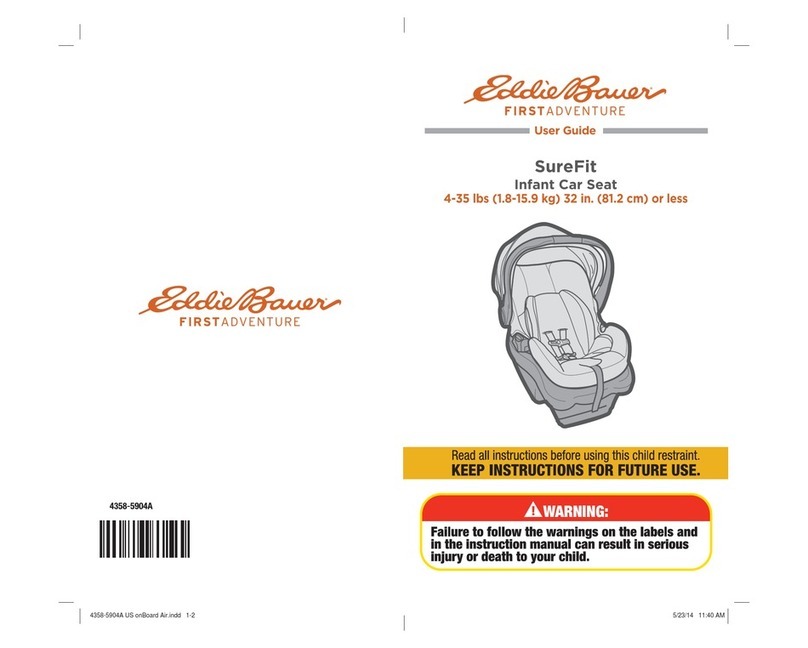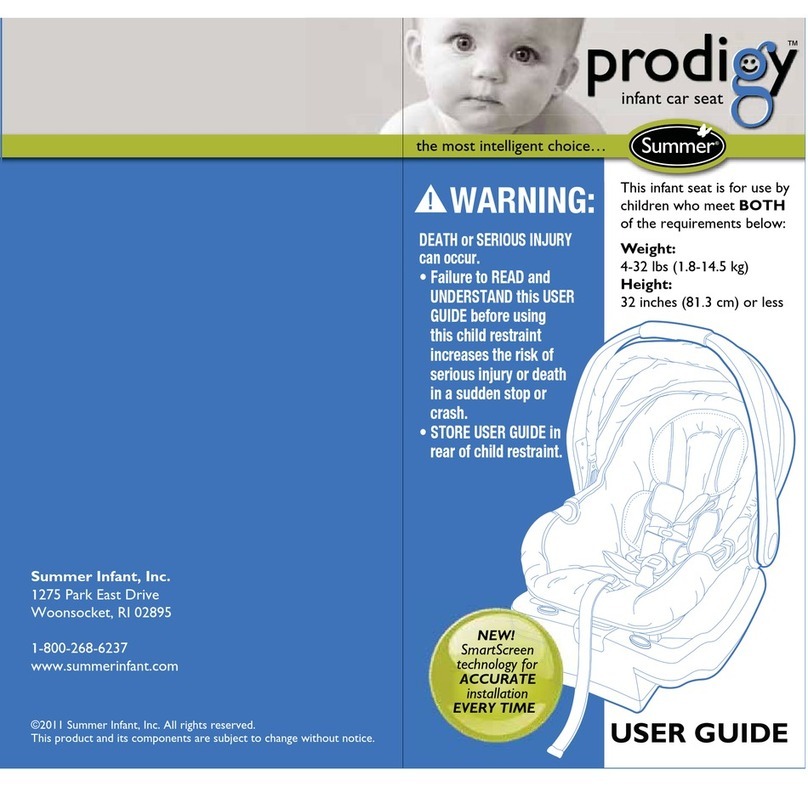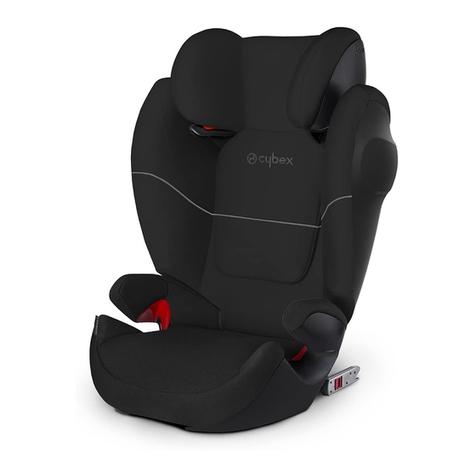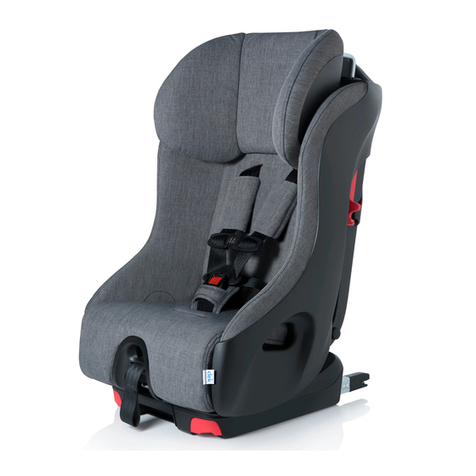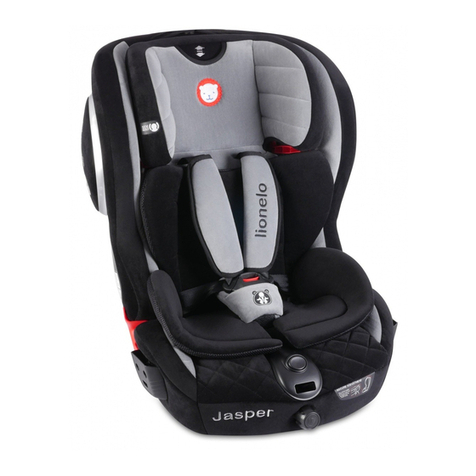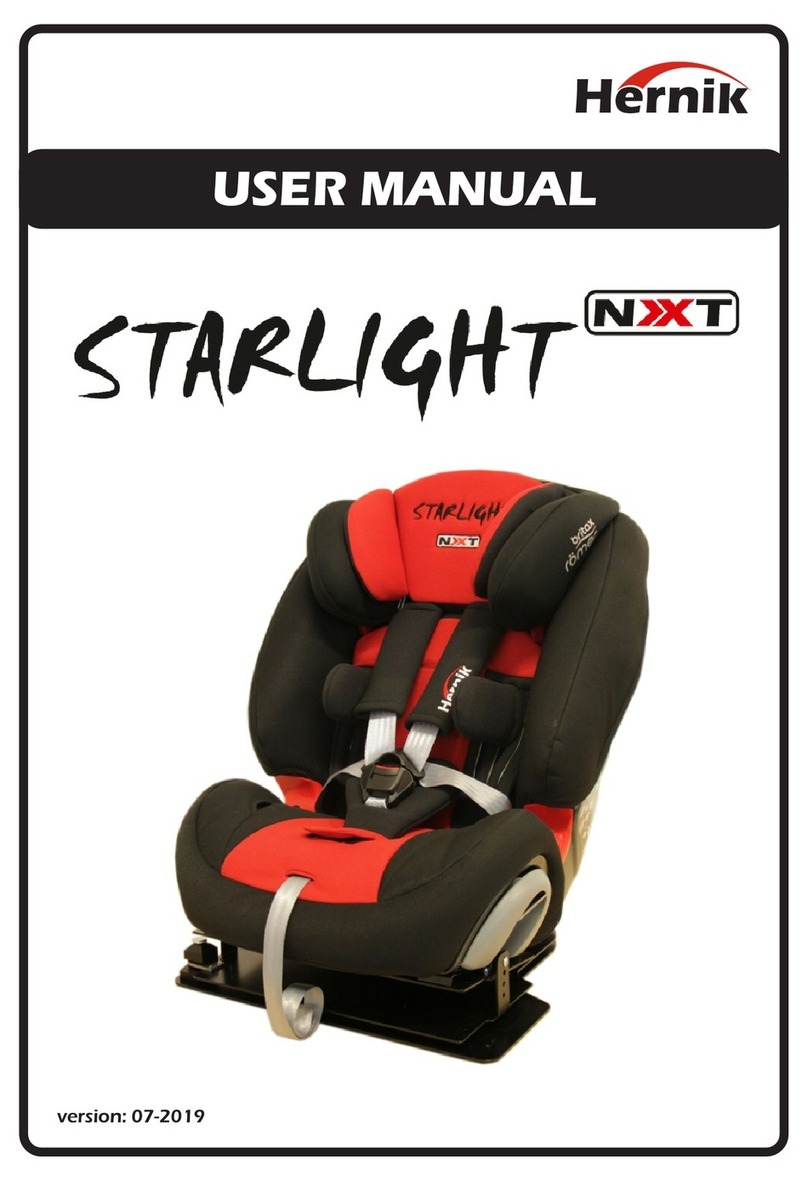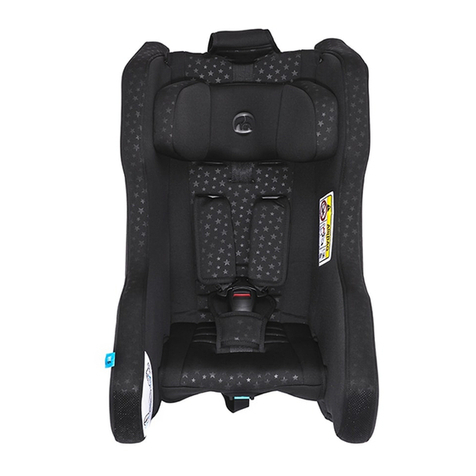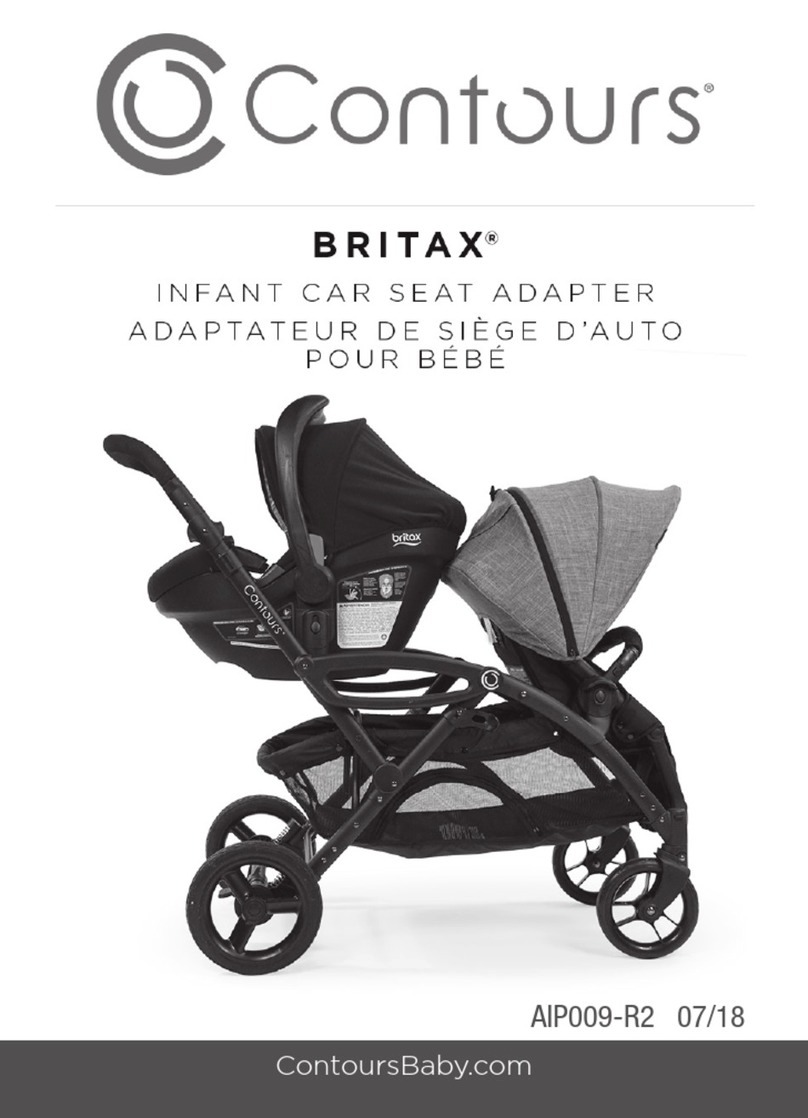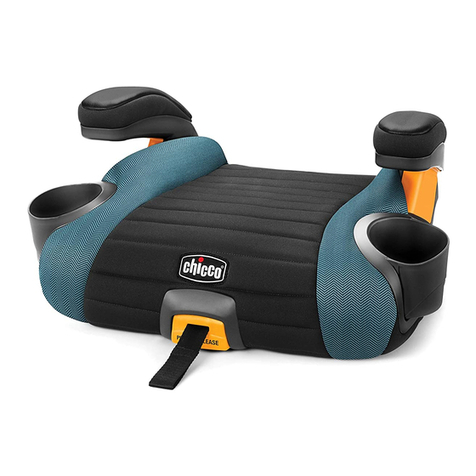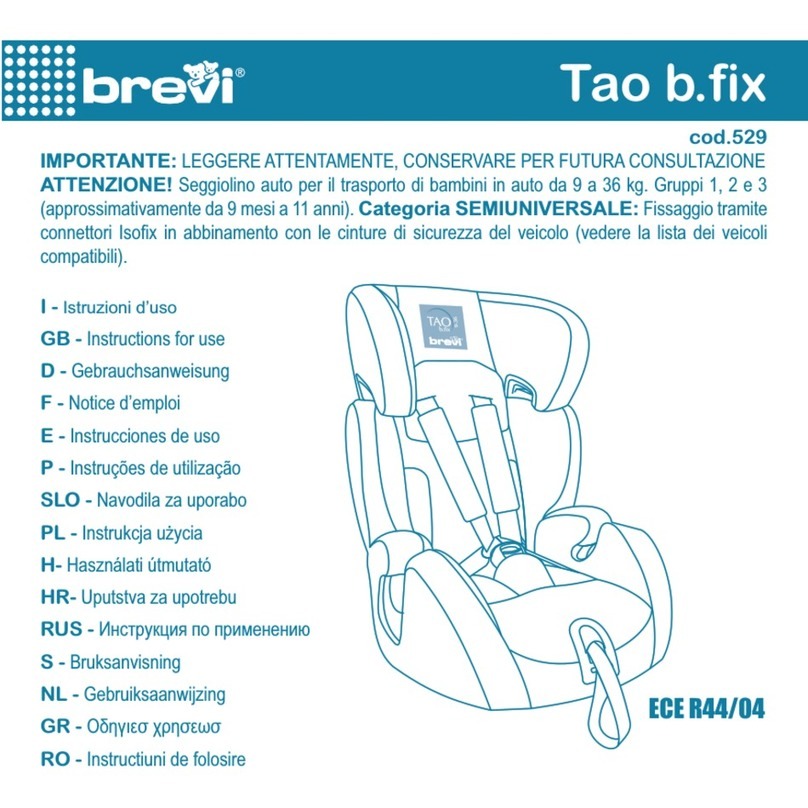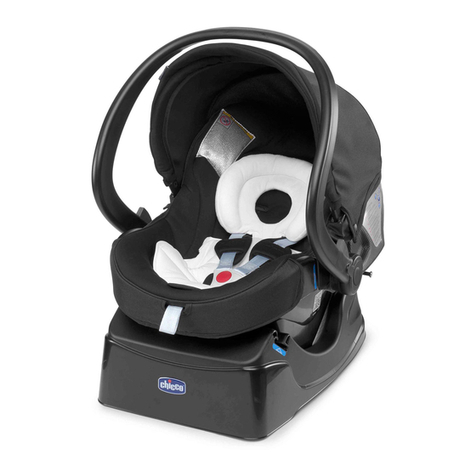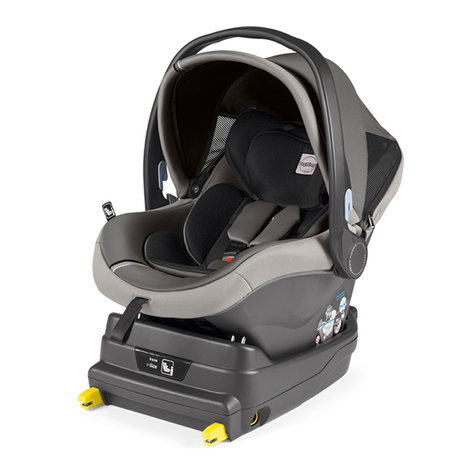Eddie Bauer surefit User manual

© 2014 Dorel Juvenile.All Rights Reserved.
4358-6720
User Guide
SureFit
Infant Car Seat
4-35 lb (1.8-15.9 kg) 32 in. (81.2 cm) or less

12
B. Safety Information...........................Pages 9-10
B-1 Vehicle Seating Position
B-2 Installation in Vehicle
B-3 Child Restraint Use
A. Before You Begin.................................Pages 3-8
A-1 Thank You...
A-2 Registration and Safety Notices
A-3 Understanding Your Child Restraint
C. Basic Use.............................................Pages 11-31
D. General Vehicle Information....Pages 32-37
D-1 Understanding Your Vehicle
D-2 Vehicle Seating Position
D-3 Choosing LATCH or Vehicle Belts
D-4 Knowing Your Vehicle Belts
D-5 Aircraft Information
D-6 Storing LATCH
C-1 Remove and Install the Carrier to Base
C-2 Canopy Use and Installation
C-3 Carrier Use
C-4 Child Restraint Use
C-5 Preparing Child Restraint to Fit Your Child
C-6 Securing Child in Child Restraint
C-7 Removing Child from Child Restraint
C-8 Reclining the Base
C-9 Removing Harness System
C-10 Removing Pad for Cleaning
C-11 Installing Harness System
C-12 Accessories on Select Models
E-1 Rear Facing Installation with Base
E-2 Installing Base with LATCH
E-3 Installing Base with Vehicle Belts
E-4 Rear Facing Installation without Base
E-5 Installing Child Restraint with Vehicle Belts
E. Installing Rear Facing.......................Pages 38-49
General Information.............................. Pages 50-56
Using a Locking Clip
Troubleshooting
Replacement Parts Order Form
Replacement Parts List
Warranty

34
A. Before You Begin
Thank you for choosing this car seat, referred to throughout
this manual as a child restraint. The DJG family is committed
to creating a child restraint with the most comfort and
convenience available today.
Remember, parents are a child’s first teachers and
examples. If you always buckle your seat belt, your child will
think it is the natural thing to do. Make it a firm rule that the
vehicle does not go until everyone is buckled up. Make no
exceptions.
No one can predict if use of a child restraint will prevent
injury or death in a particular crash. However, combined with
careful driving, proper use of a child restraint can lower a
child’s risk of injury or death in most crashes.
Your child’s safety is worth the time it will take to read and
follow these instructions. After reading, if you still have
questions or any concerns with this child restraint, please
contact our Consumer Relations Department at:
Dorel Juvenile Group, Inc.
Website: www.djgusa.com
Email: [email protected]
Fax: 1-800-207-8182
Mailing Address: Dorel Juvenile Group, Inc.
P.O. Box 2609
Columbus, IN 47202-2609
Telephone: 1-800-544-1108
8 A.M. to 6 P.M. EST M-TH
8 A.M. to 4:30 P.M. EST FRI
A-1 Thank You...
Para recibir las instrucciones en español, llame al
1-800-544-1108 o solicitarse por escrito al dirección por arriba.
Please complete the postage-paid registration card that
came with your child restraint, and send it to us. Child
restraints could be recalled for safety reasons. You must
register this restraint to be reached in a recall. Send
your name, address, email address if available, and the
restraint’s model number and manufacturing date to:
Dorel Juvenile Group, Inc.
PO Box 2609, Columbus, IN 47202-2609
Attn: Consumer Relations
or call 1-800-544-1108 or register online at www.
djgusa.com/registration/carseat/us.
For recall information, call the U.S. Government’s Vehicle
Safety Hotline at 1–888–327–4236 (TTY: 1–800–424–
9153), or go to http://www.NHTSA.gov
If you don’t have the card or if your
address changes, you will find the
model number, manufacture date,
and line code on the label located on
the underside of the shell.
A-2 Registration and Safety Notices
Example of model number and manufacture date.
Model
Number Line Code Manufacture
Date

56
A. Before You Begin
A-3 Understanding Your Child Restraint
Front View
Harness System Detail
B.
C. C.
G.
A.
E.
D.
A. Canopy
B. Carry Handle
C. Handle Adjustment
Button
D. Infant Insert
(on select models)
E. Harness Release
Lever (under flap)
F. Harness Adjustment
Strap
G. Base Adjustment
Button
F.
H. Angle Indicator
I. Carrier (shell) J. Base Release Handle
K. Removable Base
Back View
H. J.
I.
L. Chest Clip
M. Harness Straps
N. Buckle Tongue
O. Buckle
P. Buckle Strap
Q. Buckle Strap Slots
K.
L.
N.
P.
M.
O.
Q.
N.
continued on next page.

78
A. Before You Begin
A. Base Release Lever
B. Harness Slots
C. Harness Straps
D. Base Attachment
Hooks
E. Splitter Plate
F. Instruction Manual
Storage
G. Harness Adjustment
Strap
Bottom of Carrier Top of Base
H.
H. Base Belt Path
Openings
I. Base/Carrier Lock Bar
J. LATCH Belt
I.
J.
A. B.
C.
D. D.
E. F.
G.

910
B-3 Child Restraint Use
This child restraint must only be used
when the child weighs between 4-35 lb
(1.8-15.9 kg).
Never take your child out of the child
restraint while the vehicle is moving.
Never leave child unattended.
Placing your child in a hot child
restraint may result in burns.
Do not use a child restraint with
damaged or missing parts.
Do not use cut, frayed or damaged
harnesses.
Do not lubricate buckles and fasteners.
Do not substitute parts or try to modify
the child restraint in any way.
Do not use any child restraint accessory
except those approved by Dorel Juvenile
Group.
Never allow any child to play with this
child restraint; it is not a toy.
Do not remove or cover up any of the
warning labels or other labels on the child
restraint.
Read all instructions for additional
warnings.
On the underside of the shell there is an
expiration date for use of this child
restraint. Do not use this child restraint
after the expiration date.
B-1 Vehicle Seating Position
Never place a child rear facing
in a seating position with an active
frontal airbag.
Check the vehicle owner’s manual
for more information about airbag/child
restraint use.
For vehicles without a back seat, refer to
your vehicle owner’s manual.
Failure to follow these warnings can result
in the serious injury or death of your child.
To help you recognize instructions which
are most critical to your child’s safety, we
use this symbol:
B-2 Installation in Vehicle
Check the vehicle belt or LATCH belt
before each use. Use only if the belt is
tightened properly and securely.
This child restraint should be securely
belted in the vehicle even when not in use.
In a crash or sudden stop, an unsecured
child restraint could injure occupants.
Do not use a child restraint that has
been in a crash. You must get a new child
restraint.
B. Safety Information

To Remove Carrier
from Base
From the back of the
carrier, pull the base
release handle out and lift
the carrier out of the base.
To Install Canopy
Completely thread the
plastic strip through the
tunnel in front edge of the
canopy.
To Attach Carrier to
Base
Align the notches in the
front of carrier with the
base lock bar.
Push down firmly to lock.
You will hear a “click”
when it is locked.
Pull up on carrier to make
sure it is locked.
Attach Canopy to
Carrier
Fit back of canopy over
back of carrier.
Snap each plastic strip
end to each canopy post.
To Adjust Canopy
Grasp the front of the
canopy and move it
forwards or backwards to
desired location.
1.
2.
11 12
C. Basic Use
C-1 Remove and Install the Carrier to Base
Failure to securely attach carrier to base can
result in serious injury or death.
C-2 Canopy Use and Installation

13 14
C. Basic Use
WARNING:
Read ALL instructions before using child
restraint as a carrier.
NEVER
use carrier unless child is properly
secured.
Use only as a carrier by children weighing
4-35 pounds (1.8-15.9 kg) and 32 inches
(81.3 cm) or less.
NEVER leave child unattended. Always keep
child within arm’s reach.
Suffocation Hazard: Infant carrier can roll
over on soft surfaces and suffocate child.
NEVER place carrier on beds, sofas or other
soft surfaces.
Strangulation Hazard:
Children have
STRANGLED
in loose or partially buckled
harness straps. Fully restrain the child
even when carrier is used outside the
vehicle.
Fall Hazard: Child’s movement can slide
carrier. NEVER place carrier near edges
of counter tops, tables or other elevated
surfaces.
Do not use the carrier if it is damaged or
broken, or if any parts are missing.
To Adjust Carrying
Handle
Squeeze both adjustment
buttons on each side of
handle.
Rotate up or down to
desired location.
Release buttons.
Make sure both handle
adjuster buttons are
locked.
Handle MUST be
upright AND locked
when carrying and
when installed in
the vehicle.
C-3 Carrier Use
DO NOT use in the
seating area or
across the top of
shopping carts.

To Remove Carrier
from Base
From the back of the
carrier, pull the base
release handle out and
lift the carrier out of the
base.
Loosen Harness
Push down on the harness
release lever (under flap
on the front of restraint)
while pulling out on the
harness as shown.
Release Chest Clip
Press on chest clip
release button and pull
apart.
2.
3.
15 16
C. Basic Use
C-4 Child Restraint Use
This child restraint is to be used rear facing with children
weighing 4-35 lb (1.8-15.9 kg) AND 32 in. (81.3 cm) or less.
NOTE: If your child does not meet the criteria for the rear
facing position, do not use this child restraint.
4-35 lb (1.8-15.9 kg)
and 32 in. (81.3 cm) or
less
Rear Facing with base:
Child and child restraint with
base face the back of the
vehicle and are placed in the
back seat.
4-35 lb (1.8-15.9 kg)
and 32 in. (81.3 cm) or
less
Rear Facing without
base:
Child and child restraint
without base face the back
of the vehicle and are placed
in the back seat.
C-5 Preparing Child Restraint to Fit
Your Child
You MUST make these adjustments with your child
before you install the child restraint in the vehicle.
1.
continued on next page.

Unbuckle Harness
Press red button.
Pull buckle tongues out.
Place harness straps out
of the way.
For small infants, skip to
step c.
Insert the buckle’s metal
retainer through the
desired slot.
Make sure that the buckle
is facing out.
Place Child in Child
Restraint
Place the child’s bottom
and back flat against the
restraint.
This will allow the harness
straps to be properly
tightened.
Pull up on buckle strap to
make sure it is secured.
The buckle must not
pull out.
Check Buckle
Position
Determine which of the
available buckle positions
will provide a snug fit for
your child.
To Change Buckle
Position
Remove child.
From under the seat,
rotate the metal retainer
then insert retainer up
through the carrier and
pad.
Buckle Placement for
Small Infants
Choose the slot closest to
the back of the restraint.
Push metal retainer
through the pad and
carrier.
Make sure that the buckle
is facing out.
4. a.
5. b.
6.
7. c.
17 18
C. Basic Use
Failure to reinstall the harness system
correctly can result in serious injury or
death.
continued on next page.

From the bottom, pull the
metal retainer through the
carrier and insert it into
the middle slot.
Check Harness Height
With child in the child
restraint, check the
location of the harness
slot.
Follow the guidelines
below to determine the
correct harness height.
From the front, lift pad up
and place the buckle’s
metal retainter flush on
bottom of the carrier.
Replace the pad.
Pull up on buckle strap to
make sure it is secured.
The buckle must not pull
out.
To Change Harness
Location
With harness system
loose, from the back,
remove harness from the
splitter plate.
d.
e.
f.
9.
8.
10.
19 20
C. Basic Use
Rear-Facing Position
Upper harness slots must be
even with or just below the
shoulders.
If the lowest upper harness slots
are above the child’s shoulders,
do not use this child restraint.
From the front of child
restraint, pull harness
straps out.
continued on next page.
Failure to reinstall the harness system
correctly can result in serious injury or
death.

Rethread harness into new
harness slot location.
Make sure harness straps
do not twist.
Attach Harness Straps
to Splitter Plate
From the back of the
child restraint, fit the
harness strap loops onto
the splitter plate.
The sewn end of the
harness strap loops
MUST face towards you.
DO NOT twist harness
straps or harness adjustment strap and make sure
the harness straps are COMPLETELY ON the splitter
plate.
Position Harness
Straps Over the
Child’s Shoulders
Buckle Harness
Push each buckle tongue
into buckle until you hear
a “click.”
Pull up on harness straps
to make sure buckle is
locked.
11.
12.
1.
2.
21 22
C. Basic Use
Do not use this child restraint rear-
facing if the top of your child’s head
is within 1 in. (2.5 cm) from the top
of the child restraint.
Make sure the harness height is correct for
your child’s size.
Make sure you have reinstalled the harness
system correctly.
Failure to follow these steps can result in
serious injury or death.
2.5 cm
1 in.
C-6 Securing Child in Child Restraint
continued on next page.
DO NOT put snowsuits or
bulky garments on your
infant when placing them
in the child restraint.
Bulky clothing can prevent
the harness straps from
being tightened properly.
To keep infant warm,
buckle your infant in the child restraint
and place a blanket around the infant or
place the infant’s coat on backwards after
buckling in.
Failure to follow these steps can result in
serious injury or death.

Close Chest Clip
Insert right half of chest
clip into left half and snap
together.
Tighten Harness
Pull on harness
adjustment strap to
tighten harness snugly.
NOTE: A snug strap should
not allow any slack. It lies
in a relatively straight line
without sagging. It does
not press on the child’s
flesh or push the child’s
body into an unnatural
position.
Check Harness
Tightness
Try to pinch the harness
at the shoulders vertically
between index finger and
thumb.
If you can pinch the
harness strap, tighten
more.
If your fingers slip off, the
harness is tight enough.
Position Chest Clip
The chest clip must be
placed at mid-chest (even
with armpits) and away
from the child’s neck.
3. 6.
23
Failure to fasten and tighten the harness
system correctly and snugly can result in
serious injury or death.
4.
C. Basic Use
24
5.

Remove Harness
Straps
(1) Pull harness through
the upper harness slots
from the front.
(2) Unthread harness
from the chest clip.
(3) Do not unbuckle
the buckle. Unthread
harness from the buckle tongues.
You do not need to fully remove the harness strap from
the shell.
Release Chest Clip
Press on chest clip
release button and pull
apart.
Unbuckle Harness
Press red button.
Pull buckle tongues out.
Place harness straps out
of the way.
Remove child.
2.
3.
25
C-7 RemovingChild From ChildRestraint
Loosen Harness
Push down on the
harness release lever
(under flap on the front of
restraint) while pulling out
on the harness as shown.
1.
26
C-8 Reclining the Base
The base has multiple recline positions. Use any of these to
help you achieve the recline angle needed for the weight of
your child.
Push in on the base
adjustment button and
either lift or lower front of
base.
Remove Harness
Straps from Splitter
Plate
Fully loosen harness
straps. Locate splitter
plate on the back of
the child restraint and
unfasten the harness
straps.
1.
C-9 Removing Harness System
C. Basic Use
1
2
3
2.

27
C. Basic Use
28
C-10 Removing Pad for Cleaning
You must remove the harness system to remove the
pad from the shell. See section C-9.
Replace child restraint pad by reversing order:
Starting from top of the child restraint, slip pad on shell.
Pull buckle and harness adjustment strap through pad.
Slip pad over front of shell.
Attach all of the tabs on the sides of shell.
Rethread harness (see section C-11).
Cleaning Pad
Machine wash separately with cold water on a gentle
cycle. Do not use bleach. Tumble dry separately for
10-12 minutes on low heat. Remove immediately.
Spot clean the harness straps.
Do not use child restraint without the pad.
Release thePad Tabs
To release the tab, pull
down on the pad and pull
the tab out of the carrier.
Depending on your model,
unhook pad from the tabs at
the top of the carrier (A).
1.
Remove Pad fromTop
and Bottom
2.
A
Pull BuckleThrough Pad
Remove pad.
3.

29
C. Basic Use
Thread Harness Strap
If you have fully removed
the harness strap from
the child restraint, (1)
with sewn end of the
harness strap loop
facing the buckle, thread
the harness strap down
through lower harness slot
on left side of shell.
(2) Weave the harness
in and out of the shell,
between shell and pad, as
shown.
1.
30
C-11 Installing Harness System
Failure to reinstall the harness system
can result in serious injury or death.
Take both ends of the
harness strap and make
them even in length.
The sewn ends of the
harness strap loops
MUST face each other as
shown.
(3) Thread left harness
strap through the back
of the left buckle tongue.
Repeat for right harness
strap.
(4) Thread the chest clip
from front to back as
shown.
(5) Push harness ends
through upper harness
slots at same height.
DO NOT twist harness
straps.
3
45
1
2
4
2.
Attach Harness Straps
to Splitter Plate
From the back of the
child restraint, fit the
harness strap loops onto
the splitter plate.
The sewn end of the
harness strap loops
MUST face towards you.
DO NOT twist harness
straps or harness adjustment strap and make sure
the harness straps are COMPLETELY ON the splitter
plate.
3.

32
D. General Vehicle Information
Your vehicle’s features may be considerably different
than those pictured here. Consult your vehicle owner’s
manual to help identify your vehicle’s specific features
and locations.
D-1 Understanding Your Vehicle
LATCHAnchors
Located in the seat
bight.
AirBags
Consult your
vehicle owner’s
manual for all
airbag locations.
SeatBight
VehicleSeatBelts
Consult your vehicle
owner’s manual for
vehicle belt use.
Safety Tip:
To avoid your child being seriously burned,
take the following precautions:
1. Park in the shade or where sun does not
directly hit the child restraint.
2. Cover the child restraint with a sheet or blanket
when not in use.
3. Check for hot child restraint and buckles before
placing child in child restraint.
31
C-12 Accessories on Select Models
To help protect your vehicle seat’s upholstery from damage,
use a single layered towel underneath and behind child
restraint.
Infant Insert
Infant insert MUST NOT cover
the infant’s face in any way.
Remove the insert when the
infant’s head has reached the
top, inside part of the insert.
To remove this insert, undo
the fastening strips and slide
the insert out.
Reverse steps to replace
support.

33 34
D. General Vehicle Information
D-2 VehicleSeating Position
Some seating positions in your vehicle may not be safe for
this child restraint. Some vehicles do not have a seating
position that can be used safely with this child restraint. If
you are not sure where to place the child restraint in your
vehicle, consult your vehicle owner’s manual or contact Dorel
Juvenile Group Consumer Relations Department.
Use the child restraint only on vehicle seats
that face forward. Do not use on seats that
face the sides or rear of the vehicle.
Safety Tip:
Children are safer when
properly restrained in
rear seating positions
than in the front seating
positions.
According to National Highway Traffic
Safety Administration information, children
in rear seating positions are statistically
safer, whether you have airbags, advanced
airbags, or no airbags at all.
Never place a child rear facing in a
seating position with an active frontal
airbag. This can result in serious
injury or death.
Vehicle Belts
If LATCH is not an
option, you must use
the vehicle seat belt
system to install the
child restraint. There
are some vehicle belts
that will not work
with a child restraint
or will require special
attention. See next page and check your vehicle owner’s
manual for specific instructions.
The LATCH System
LATCH (Lower
Anchors and Tethers
for CHildren) is a
universal system
for installing child
restraints without
using vehicle seat
belts.
The LATCH system can ONLY be used in vehicles that
have the LATCH anchor bars installed and designated
LATCH seating positions. Most vehicles manufactured
after September 2002 are equipped with LATCH.
Check your vehicle owner’s manual to see which seating
positions may be equipped with the LATCH system.
D-3 Choosing LATCH or Vehicle Belts
LATCHAnchorBars
Do not use both the LATCH belt and
vehicle belt at the same time.

35 36
D. General Vehicle Information
Review your vehicle owner’s manual for vehicle seat belt use
with child restraints. This is your best source for information
concerning your vehicle.
Not all vehicle belts will work with this child restraint. This
child restraint must be tightly locked in place at all times,
during travel. You must determine if your vehicles belts are
compatible with this child restraint.
Vehicle Belts
• Automatic/Passive vehicle seat belts
You MUST have a vehicle lap belt to install any child
restraint. An automatic (passive) shoulder vehicle belt may
or may not have a separate vehicle lap belt. Consult your
vehicle owner’s manual.
• Vehicle belts in center of the door
or side panel
You must move the child restraint to
another seating location. Consult your
vehicle owner’s manual.
• Vehicle belts that are in front of the
seat bight
You may need to move the child restraint
to another seating location. Consult your
vehicle owner’s manual.
• Do Not Use with inflatable seat belts
You may need to move the child restraint to another seating
location or use LATCH belts only.
• ELR (Emergency Locking Retractor) vehicle belts
These lap and shoulder vehicle belts only lock in a sudden
stop or crash, and do not properly secure a child restraint
alone. Consult your vehicle owner’s manual.
To determine if you have this type of
vehicle belt, gently pull the vehicle belt
all the way out of the retractor (spool),
let it return several inches, then pull on
it again.
D-4 Knowing Your Vehicle Belts
• Switchable retractor
These vehicle belts switch from ELR to ALR (Automatic
Locking Retractor). You must have the vehicle belts in
the locking mode to use them. Follow the instructions in
the installation sections.
• ALR (Automatic Locking Retractor)
These vehicle belts lock after pulling the webbing out
and letting the vehicle belt go back into the retractor an
inch or two. Follow the instructions in the installation
sections.
Vehicle Latch Plates
• Check the Latch Plates
Grasp the tongue portion of
the latch plate (the part that
goes inside the buckle) and
pull straight out, in line with
the vehicle lap belt. If the
latch plate does not slide up
and down the vehicle belt,
you have a locking latch plate.
You should not need to use
a locking clip. Consult your
vehicle owner’s manual.
If the latch plate slides up and down on the vehicle belt,
and you have an ELR retractor, you MUST use a locking
clip to install the child restraint. You may not need to
use the locking clip with a switchable or ALR retractor.
Consult your vehicle owner’s manual.
Locking
Latch
Plate
Sliding
Latch
Plate
ELR lap-only vehicle belts MUST NOT be
used with this child restraint.
If it moves freely, it is an ELR vehicle belt.
If it is locked and will not allow any more vehicle belt to
come out, it is a switchable retractor.

37
Attach LATCHHooks
to Barsin Storage
Location
D-6 Storing LATCH
D-5 Aircraft Information
Failure to securely store the LATCH belts
can result in serious injury or death.
38
LATCH Belt Lap Belt
Lap/Shoulder Belt
E-1 Rear Facing Installation with Base
Never place a child rear facing in a
seating position with an active frontal
airbag. This can result in serious
injury or death.
This child restraint must always face the rear
of the vehicle.
This restraint is certified for aircraft use.
Use only on forward-facing aircraft seats.
Follow instructions for vehicle installation
in section E-5.
Contact the airline for their specific
policies.
E. Installing Rear Facing
Other manuals for surefit
1
Table of contents
Other Eddie Bauer Car Seat manuals
